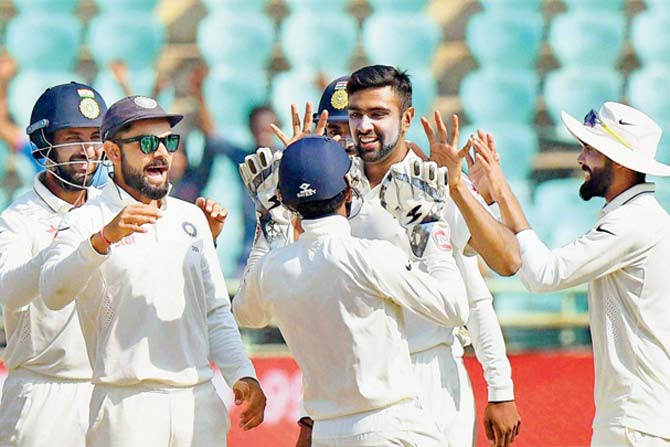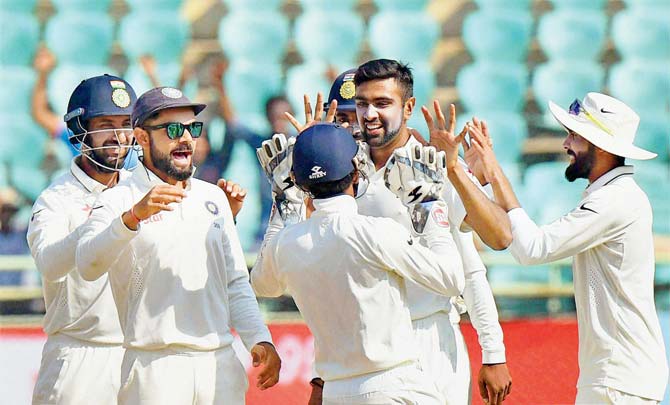A tour of the sub-continent, especially India, has this habit of spawning fables and homespun truisms that often don’t do justice to a cricketing journey that is far too complex to wrap up in a convenient one-liner


Team India celebrate yet another moment of success during the recent Test series against England which the home team won 4-0. Pic/PTI
This year should be the one of dispelling modern cricket myths. A tour of the Asian sub-continent, especially India, has this habit of spawning myths, legends and homespun truisms that often don’t do justice to a cricketing journey that is far too complex to wrap up in a convenient one-liner. Foreign teams, particularly Australia, have developed a number of theories about how to beat the hosts at home. Most of those theories are out-dated or ultra-contemporary, ignorant to the ever-changing landscape and sophisticated nuances of touring a country as diverse as India.
ADVERTISEMENT
To a people as culturally diverse as India — to make generalisations about cultures that span the Sikhs in the north to the Tamils in the south and a rich mix of mini-nations in between, is to mistake diversity for homogeneity. The colonial rulers never quite mastered it — it is unlikely that the Australian cricket team will weaken India’s defences by following Steve Smith’s theory that ruffling Virat Kohli’s feathers, in other words, verbally taunting him, aka sledging, is going to work. Have they learned nothing from studying the history of the Indian psyche, the passive/aggressive method made famous by Gandhi?
To begin with, this new Indian team is so much more than Kohli. It is a team made up of wonderfully skilled cricketers who know their own conditions inside out and no longer have the colonial cringe mentality that sometimes led to past Indian teams being too meek and hospitable in the face of a firestorm. Whilst the batting has Kohli as its flagbearer, the recent Chennai innings showed that even when Kohli fails, 700-plus scores are comfortably within range. The bowling too relies on Ravichandran Ashwin as the leader of the pack but take the likes of Ravindra Jadeja and the genuine quicks lightly at your own peril. The fielding, especially the close catching at bat-pad and leg-slip, is far superior to anything that a non-Asian team can boast and this is a crucial advantage.
For a country steeped in literature and a myriad of languages, words are cheap. What will count can be measured on the scoresheet, not in simplistic mind games that Australians think they have a monopoly on.
This Indian team is a far cry from their meek predecessors — if Australia forget to focus on their own game and devote too much attention to ruffling Kohli’s feathers, they may just win a battle or two but they will convincingly lose the war. Tired pitches towards the end of the cricket season will test the Aussies in ways that will focus every sinew on coming up with plans for their own survival, rather than plotting the famous ‘mental disintegration’ tactics that never really worked in India.
The Australians used to live by the mantra that to lose your patience in Asia is to lose the war. That harked back to an era where it referred to more than just the on-field action.
It was as much a comment about the allegedly sub-standard conditions that had to be endured, rather than enjoyed. Whilst that mentality is no longer in vogue, Australia’s recent tour of Sri Lanka was evidence of the sort of panic that led to them moving away from that mantra. With the bat especially, when the ball was turning, patience was abandoned in a flurry of reverse sweeps and adventurous strokes that played perfectly into the hands of the host. Re-discovering a genuine belief in that theory, and then being patient enough to execute it, may well be the key to competing with India.
England went for the bold approach, trying too hard to take the attack to India. They paid a heavy price. Australia could do worse than to take some lessons from the Brits. It is often the case, especially on turning pitches, that you need to wear bowlers down. If you get beaten on the outside edge, smile ruefully and have faith in your defensive technique. The ‘if in doubt, hit out’ approach can work on pitches where the fast, bouncing ball can fly off the edges and a batsman can build momentum, like Ian Botham in that famous match-turning innings at Headingley in 1981. Indian pitches tend to favour the opposite approach — go even more on the attack when you’re on top but you may have to be prepared to grind your way out of a hole with patience and grit. Matthew Hayden took the attacking approach at the top of the order when Australia was looking to dominate, but it might take the patience of a Dean Jones or Allan Border to win more than a long war of attrition.
Ask any hard-nosed Australian cricketer, hewn from the rock of Border, if they crumbled when the blowtorch was applied and they’ll give you a scornful look. They reckon that the more you ruffle their feathers, the better they play. Border is even on the record as saying he sometimes went looking for conflict in order to fire himself up. So why is it they think that deliberately riling a player of Kohli’s calibre would have the opposite effect? Have they not watched him bat? The more pressure, the more aggro, the more acid… the more runs he scores. Australians do not have a monopoly on mental toughness. It would be a simple game otherwise — forget batting and bowling skills, just become mentally tough.
Theâu00c2u0080u00c2u0088Indian jungle, like the African bushveld, has more than one threat that you need to keep an eye out for. As a wildlife ranger in Africa (when I’m not watching cricket!), I can tell you that the biggest mistake you can make is when you focus too much on the lion or elephant that you can clearly see.
It’s sometimes the one that sneaks up on you, the one you never knew was there, that gives you an almighty fright. Winning the Border-Gavaskar Trophy is not impossible for this talented Australian team but it may need more subtlety than a strategy that relies upon poking a King Cobra with a blunt stick. The venom of a krait can sometimes result in a slow paralysis but the end result is just as terminal.
 Subscribe today by clicking the link and stay updated with the latest news!" Click here!
Subscribe today by clicking the link and stay updated with the latest news!" Click here!







